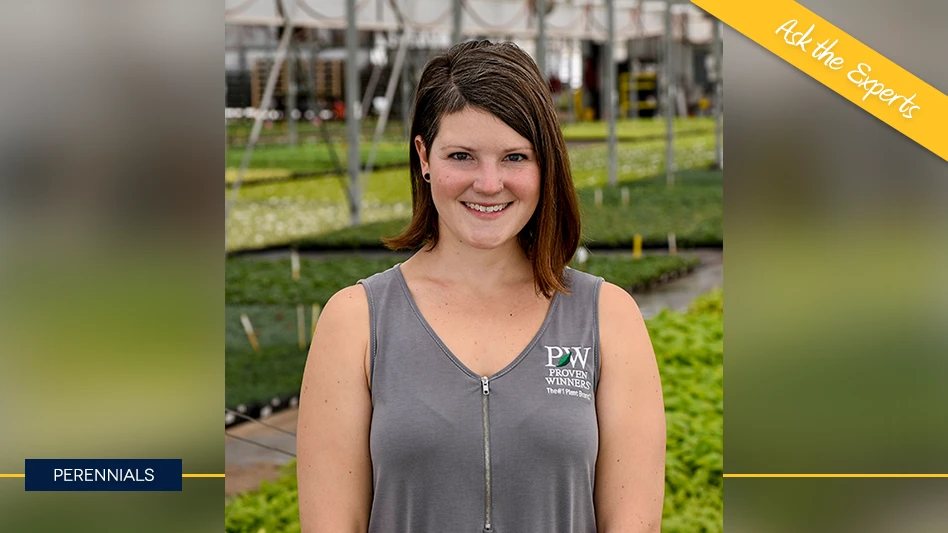

NM: What’s the best time to start a sedum crop?
CS: Yesterday! Just kidding, but they can be a crop that can take a little longer to produce. Sedum can be bulked over the summer and sold the following spring when planted from a 72ct plug. One to two pinches are recommended for the best branching. They can also be finished into true 1 or 2 gallons in the same season from a bare root plant, which can take between 8 and 14 weeks depending on the variety and time of year. Growing them from bare root gives you the option to succession plant them as well, so that you can keep benches stocked with color all season long. Sedum do require long days to flower, so their best season for growth and flowering is summer through fall.
NM: What growing conditions do sedum prefer in containers and in the garden?
CS: Sedum prefer to be in well-drained soils and to be allowed to dry down between waterings. They prefer warmer conditions between 70-75° F during the day and above 55° F at night. High light conditions are also beneficial for these sun-loving varieties. Dark-leaved varieties require UV radiation for their foliage to darken in color. They must be grown outside or in open-roofed greenhouses to achieve their most vibrant coloration. In a garden setting they should be planted in direct sun with six or more hours of sun.
NM: What pests or diseases can impact a sedum crop, and what are the best ways to avoid them?
CS: While thrips can be an issue on sedum, primarily when they are flowering, aphids tend to be their main pest. Keep an eye out for them at points of growth especially when the plants are young or just re-emerging after winter. Powdery mildew can also affect sedum and leave unsightly scarring on the leaves even after the mildew has been neutralized. If soil or media conditions are overly wet, the plants can succumb to root, crown or stem rot. If rot is found, plants should be culled to prevent the spread, since treatment of the disease is not an option.
NM: What is the one thing that most growers could get wrong with growing sedum?
CS: Sedum will quickly die if the crown is planted too deep. Not spacing the plants adequately can also lead to increased challenges with powdery mildew or stem root. Also, some taller varieties of perennial sedum tend to open their crow up and spit, so growers shouldn’t be afraid to apply a small amount of plant growth regulators such as uniconazol or daminozide/chlormequat mix to help give container-grown sedum the advantage of having compact, well-branched growth that is less likely to split in the center.
NM: There are lot of different sedum out there, what are the different types and how can they be used differently in the garden?
CS: There are groundcover sedum that create a mat of prostrate growth. These are excellent for rock gardens and border areas, since they don’t need much moisture and can tolerate some light traffic. Next, you have S. kamtschaticum type hybrids. These are low-growing, but have a slightly more height than the prostrate mat of the groundcover types. They form a neat, little dome with their rounded, mounded habit. These typically have yellow flowers, and can have deep, glossy green or variegated foliage. The similarly-shaped S. tatarinowii hybrids also form a tidy dome, great for containers or the front of the border. They are defined by their glaucous green to blue foliage and flowers that range from white to deep pinks. Lastly, there are the tallest S. spectabile hybrids most commonly called upright sedum. These can have a diversity of foliage and flower colors. Some have dark, almost black foliage and some have flowers that are hot pink or even deep, garnet red. These sedum have robust stems and can form dense clumps that function much like a shrub in the landscape. There is a wide variety of sedum that can be used in lots of different ways in the garden.
For more: waltersgardens.com

Explore the November 2022 Issue
Check out more from this issue and find your next story to read.
Latest from Nursery Management
- Get to know Pat Reilly with NewGen Boxwood and the American Boxwood Society
- Terra Nova Nurseries introduces rust-free and disease-resistant heucherella
- John T. Nickel, founder of Greenleaf Nursery Co., passes away at 89
- Three tours offered at 2025 Farwest Show
- Garden Media Group announces sixth annual Women in Horticulture Week
- Star Roses and Plants announces National Knock Out Rose Day
- The Growth Industry Episode 4: How federal budget cuts are affecting horticulture nonprofits
- Pennsylvania Horticultural Society shares top gardening trends from 2025 Philadelphia Flower Show





